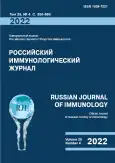Association of the cytokine profile and metabolic syndrome components in young patients
- Authors: Sumerkina V.A.1, Telesheva L.F.1, Golovneva E.S.1
-
Affiliations:
- South Ural State Medical University
- Issue: Vol 25, No 4 (2022)
- Pages: 535-540
- Section: SHORT COMMUNICATIONS
- URL: https://journals.rcsi.science/1028-7221/article/view/120139
- DOI: https://doi.org/10.46235/1028-7221-1164-AOT
- ID: 120139
Cite item
Full Text
Abstract
The components of metabolic syndrome (MS) are independent factors of cardiometabolic risk and are associated with impaired humoral immunity. However, the literature data on the cytokine profile features in MS are ambiguous. Therefore, associations between cytokine levels and MS components were determined in a group of MS patients of both sexes, as well as indices of visceral adipose tissue function were studied. The work included 149 patients aged 18-45 years. The patients were divided into 2 groups: group 1 (n = 71) included patients without abdominal obesity and MS components (comparison group); group 2 (n = 78), patients with MS. The concentrations of glucose, glycosylated hemoglobin, insulin, total cholesterol, HDL-C, LDL-C, triglycerides, leptin, adiponectin were determined. The indexes of insulin resistance HOMA-IR, Tg/HDL and TyG, as well as marker of visceral adipose tissue dysfunction VAI were calculated. ELISA technique was used to determine the concentration of IL-1β, IL-2, IL-4, IL-6, IL-8, IL-10, IFNα, IFNγ, МСР-1 и TNFα. Results: In the patients with MS, we have found increased levels of IL-6, IL-10, MCP-1, and decrease of IL-2, IL-4, IFNγ levels. Correlation analysis established a relationship between glucose levels and MCP-1; glycosylated hemoglobin and IL-6, TNFα. Among the indices of lipid metabolism, we have revealed some associations between LDL-C and IFNγ; HDL-C and IL-2, IL-4, IFNγ. The levels of triglycerides correlated with MCP-1. A negative relationship between the presence of arterial hypertension and the IL-4 contents was established. A negative correlation of leptin levels with IL-4 and IFNγ concentrations was also determined. Markers of insulin resistance (Tg/HDL and TyG) were associated with MCP-1 chemokine, thus supporting chronic inflammatory process. The VAI index, which reflects the dysfunction of visceral adipose tissue, showed a correlation with MCP-1. Thus, the results of investigation suggest an involvement of the cytokine system in the disorders of visceral adipose tissue and development of the metabolic syndrome.
Full Text
##article.viewOnOriginalSite##About the authors
V. A. Sumerkina
South Ural State Medical University
Author for correspondence.
Email: veronika.sumerkina@mail.ru
PhD (Medicine), Leading Research Associate, Central Research Laboratory
Russian Federation, ChelyabinskL. F. Telesheva
South Ural State Medical University
Email: veronika.sumerkina@mail.ru
PhD, MD (Medicine), Professor, Department of Microbiology, Virology and Immunology
Russian Federation, ChelyabinskE. S. Golovneva
South Ural State Medical University
Email: veronika.sumerkina@mail.ru
PhD, MD (Medicine), Professor, Yu. Zakharov Department of Normal Physiology
Russian Federation, ChelyabinskReferences
- Blaszczak A.M., Jalilvand A., Hsueh W.A. Adipocytes, innate immunity and obesity: a mini-review. Front. Immunol., 2021, Vol. 12, 650768. doi: 10.3389/fimmu.2021.650768.
- Braune J., Weyer U., Hobusch C., Mauer J., Brüning J.C., Bechmann I., Gericke M. IL-6 regulates M2 polarization and local proliferation of adipose tissue macrophages in obesity. J. Immunol., 2017, Vol. 198, no. 7, pp. 2937-2934.
- Dommel S., Blüher. M. Does C-C motif Chemokine Ligand 2 (CCL2) link obesity to a pro-inflammatory state? Int. J. Mol. Sci., 2021, Vol. 22, no. 3, 1500. doi: 10.3390/ijms22031500.
- Formanowicz D., Rybarczyk A., Radom M., Formanowicz Р. A role of inflammation and immunity in essential hypertension — modeled and analyzed using Petri nets. Int. J. Mol. Sci., 2020, Vol. 21, no. 9, 3348. doi: 10.3390/ijms21093348.
- Fu S., Yao Y., Lv F., Zhang F., Zhao Y., Luan F. Associations of immunological factors with metabolic syndrome and its characteristic elements in Chinese centenarians. J. Transl. Med., 2018, Vol. 16, 315. doi: 10.1186/s12967-018-1691-4.
- Hammarstedt A., Gogg S., Hedjazifar S., Nerstedt A., Smith U. Impaired adipogenesis and dysfunctional adipose tissue in human hypertrophic obesity. Physiol. Rev., 2018, Vol. 98, no. 4, pp. 1911-1941.
- Hubler M.J., Kennedy A.J. Role of lipids in the metabolism and activation of immune cells. J. Nutr. Biochem., 2016, Vol. 34, pp. 1-7.
- Janowska J., Chudek J., Olszanecka–Glinianowicz M., Semik-Grabarczyk E., Zahorska-Markiewicz B. Interdependencies among selected pro-inflammatory markers of endothelial dysfunction, C-peptide, anti-inflammatory interleukin-10 and glucose metabolism disturbance in obese women. Int. J. Med. Sci., 2016, Vol. 13, no. 7, pp. 490-499.
- Kassem K.M., Ali M., Rhaleb N.-E. Interleukin 4: its role in hypertension, atherosclerosis, valvular, and nonvalvular cardiovascular diseases. J. Cardiovasc. Pharmacol. Ther., 2020, Vol. 25, no. 1, pp. 7-14.
- Lin S.-Y., Yang C.-P., Wang Y.-Y., Hsiao C.-W., Chen W.-Y., Liao S.-L., Lo Y.-L., Chang Y.-H., Hong C.-J., Chen C.-J. Interleukin-4 improves metabolic abnormalities in leptin-deficient and high-fat diet mice. Int. J. Mol. Sci., 2020, Vol. 21, 4451. doi: 10.3390/ijms21124451.
- Liu N., Sheng J., Wang Y. Effect of stress hyperglycaemia on monocyte chemoattractant protein-1 levels and the short-term prognosis of patients with acute ST-segment elevation myocardial infarction undergoing primary percutaneous coronary intervention. Exp. Ther. Med., 2019, Vol. 17, no. 5, pp. 3823-3829.
- Monserrat-Mesquida M., Quetglas-Llabrés M., Capó X., Bouzas C., Mateos D., Pons A., Tur J.A., Sureda A. Metabolic syndrome is associated with oxidative stress and proinflammatory state. Аntioxidants, 2020, Vol. 9, no. 3, 236. doi: 10.3390/antiox9030236.
- Rodriguez-Iturbe B., Pons H., Johnson R.J. Role of the immune system in hypertension. Physiol. Rev., 2017, Vol. 97, no. 3, рр. 1127-1164.
- Rucker A.J., Crowley S.D. The role of macrophages in hypertension and its complications. Pflugers Arch., 2017, Vol. 469, no. 3-4, pp. 419-430.
- Zhuang Y., Zhang J., Li Y., Gu H., Zhao J., Sun Y., Wang R., Zhang C., Chen W., Weng J., Qi L., Lu H., Zhang J., Liu Q., He Y., Xu X. B lymphocytes are predictors of insulin resistance in women with gestational diabetes mellitus. Endocr. Metab. Immune Disord. Drug Targets, 2019, Vol. 19, no. 3, pp. 358-366.
Supplementary files







